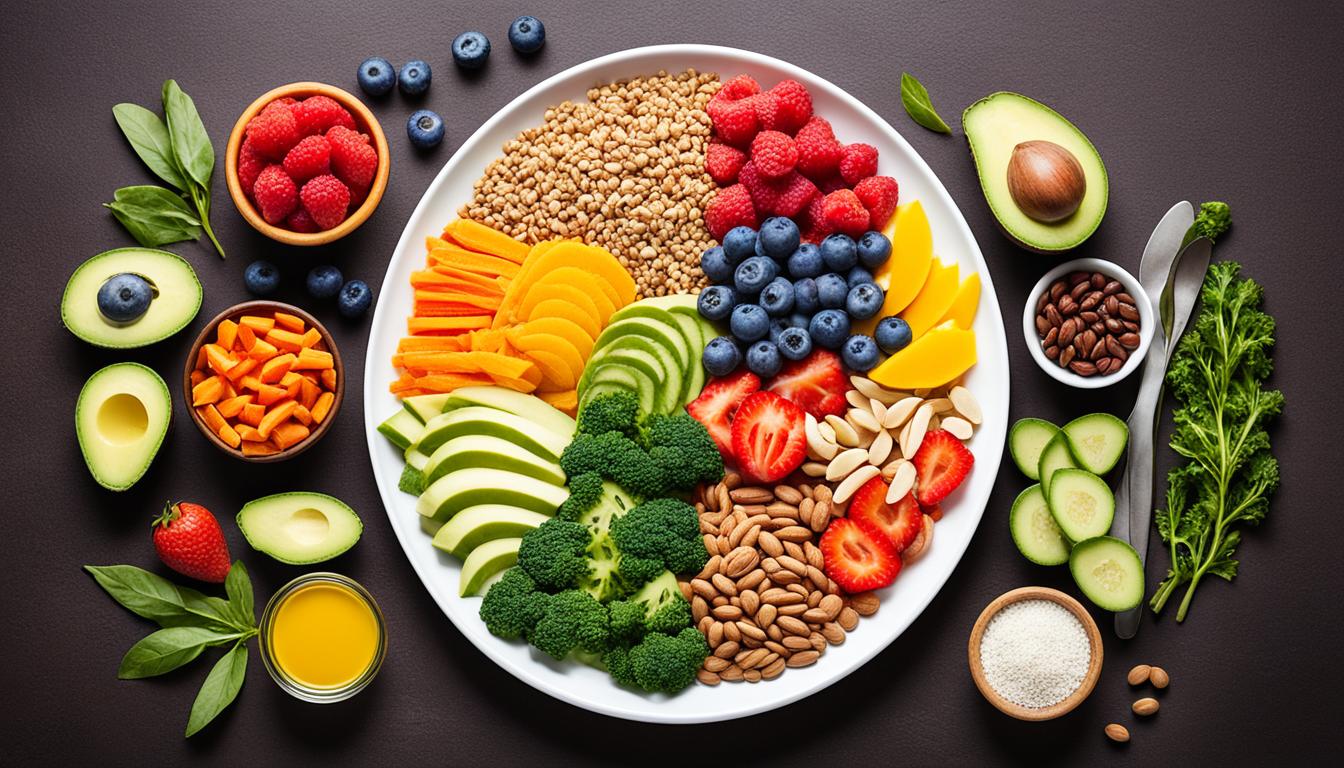Welcome to our comprehensive guide on the CCD Diet, also known as the calorie counting diet. If you’re looking to shed those extra pounds and develop healthier eating habits, then you’re in the right place! The CCD Diet is a popular method for weight loss that involves tracking and monitoring your calorie intake to create a calorie deficit. By being mindful of the calories you consume and the portion sizes you choose, you can make informed decisions about the foods you eat and achieve your weight loss goals.
Key Takeaways:
- The CCD Diet, or calorie counting diet, is a method of weight loss that involves tracking and monitoring calorie intake.
- By counting calories and being mindful of portion sizes, individuals can better understand their daily energy intake and make informed choices about the foods they consume.
- The CCD Diet offers several benefits for weight loss, including creating a calorie deficit and encouraging mindful eating and portion control.
- Incorporating nutrient-dense, whole foods is essential for maintaining optimal health while on the CCD Diet.
- The CCD Diet can be customized to meet the specific dietary needs of individuals with diabetes and chronic kidney disease.
Understanding the CCD Diet Plan
The CCD diet plan is a structured approach to weight loss that involves calculating your daily calorie needs based on factors such as age, sex, weight, and activity level. By determining your calorie goal, you can create a personalized plan to track and monitor your food intake, helping you stay within your calorie limit.
One effective way to track your calories is by using a calorie counting app or journal. These tools can help you keep a record of the foods you consume throughout the day, making it easier to stay on track with your calorie goals.
When following the CCD diet plan, it is important to prioritize nutrient-dense foods that provide essential vitamins and minerals. These foods ensure that you are nourishing your body while staying within the recommended calorie limit. To maximize the benefits of the CCD diet, consider the following tips:
- Choose whole foods: Opt for whole grains, lean proteins, and healthy fats instead of processed foods that tend to be high in empty calories and lacking in nutritional value.
- Incorporate fruits and vegetables: Fruits and vegetables are low in calories and high in fiber, vitamins, and minerals. Including a variety of colorful produce in your meals will not only add nutritional value but also enhance the flavor and overall appeal of your meals.
- Stay hydrated: Drinking an adequate amount of water throughout the day can help you feel fuller and prevent overeating. Aim to drink at least eight glasses of water daily.
- Practice portion control: Be mindful of your portion sizes. Use measuring cups or a food scale to ensure you are consuming the appropriate amount of food according to your calorie goals.
By following these tips and incorporating them into your CCD diet plan, you can make the most of this calorie counting approach and achieve your weight loss goals. Remember, consulting with a healthcare professional or registered dietitian can provide further guidance and support on your journey to better health.
Benefits of the CCD Diet for Weight Loss
The CCD diet offers several benefits for effective weight loss. By tracking calories, you can create a calorie deficit, which is essential for losing weight. This method allows you to better understand and regulate your energy intake, leading to successful weight management.
One of the key advantages of the CCD diet is its focus on mindful eating and portion control. By being mindful of what and how much you eat, you can develop a better understanding of your hunger cues and make healthier food choices. This awareness can prevent overeating and unnecessary snacking, promoting weight loss.
The CCD diet also allows for flexibility and customization. You have the freedom to choose the foods you enjoy within your calorie goals, making the diet more sustainable and enjoyable in the long run. It’s all about finding a balance and finding what works best for you.
Combined with regular exercise, the CCD diet can yield even more significant results. Physical activity helps to increase calorie burn and enhances the overall effectiveness of the diet. By incorporating exercise into your routine, you can boost weight loss and improve your overall health.
Remember that maintaining a healthy lifestyle is essential for long-term success. The CCD diet not only helps you shed excess pounds but also cultivates healthier eating habits that can last a lifetime.

The image above illustrates the benefits of the CCD diet and highlights how it can contribute to effective weight loss.
Incorporating Healthy Calorie Counting
While counting calories can be an effective weight loss strategy, it’s important to focus on the quality of the calories consumed. Opting for nutrient-dense, whole foods is key to maintaining optimal health while on the CCD diet. Including a variety of fruits, vegetables, lean proteins, whole grains, and healthy fats can provide the necessary nutrients while keeping overall calorie intake in check.
By choosing nutrient-dense foods, you can fuel your body with the vitamins, minerals, and antioxidants it needs to function at its best. These foods also help keep you feeling satisfied and full, reducing the likelihood of overeating or succumbing to unhealthy cravings.
Try incorporating more fruits and vegetables into your meals. They are low in calories but high in fiber, which promotes satiety and aids in digestion. Include lean proteins like chicken, fish, tofu, or legumes to support muscle growth and repair.
Whole grains, such as brown rice, quinoa, and whole wheat bread, provide sustained energy and fiber. They can help control blood sugar levels, reducing the risk of energy crashes and excessive snacking.
Don’t forget to include healthy fats from sources like avocados, nuts, and olive oil. These fats are essential for nutrient absorption and support heart health.
Exploring CCD Diet Recipes
Are you tired of the same old meals? Spice up your CCD diet with healthy and delicious recipes that fit within your calorie goals. There are plenty of resources available online for finding creative and flavorful dishes that align with the CCD diet.
One popular recipe is a quinoa salad with mixed vegetables and grilled chicken. This dish combines lean protein, whole grains, and a variety of colorful veggies to create a satisfying and nutritious meal. Another option is a spinach and feta omelette, which is packed with protein and essential vitamins.
When searching for CCD diet recipes, it’s important to prioritize those that use whole, unprocessed ingredients. These recipes often feature simple seasonings and cooking methods that allow the natural flavors of the ingredients to shine through.
Remember, healthy eating shouldn’t be boring or restrictive. With a little creativity and exploration, you can create meals that are both nutritious and delicious.

Understanding the Diabetes and CKD Diets
Diabetes and chronic kidney disease (CKD) often coexist, making it essential to understand and manage both conditions effectively. While the diets for diabetes and CKD share similarities, they also have significant differences. A healthy diabetes diet primarily focuses on controlling blood sugar levels and preventing kidney damage. This is achieved by incorporating fruits, vegetables, lean proteins, and limiting salt and refined carbs.
On the other hand, a CKD diet requires additional restrictions on sodium, potassium, phosphorus, and protein intake. Sodium restriction helps manage blood pressure and reduce fluid buildup, while managing potassium levels is crucial to maintain proper nerve and muscle function. Limiting phosphorus intake is essential to prevent bone weakening and damage to blood vessels, eyes, and the heart. Furthermore, monitoring protein consumption is necessary to prevent kidney strain.
Given the complexity of managing these two conditions, it is vital to seek guidance from a registered dietitian who specializes in both diabetes and CKD nutrition. They can provide personalized dietary recommendations tailored to your specific needs, ensuring that your diet supports your health goals while effectively managing both diabetes and CKD.
Expert Insight:
“A common misconception is that a diabetes diet alone is sufficient for individuals with diabetes and CKD. However, a CKD diet encompasses more specific dietary modifications to protect kidney function. Collaborating with a specialist who understands both conditions is crucial to maintain optimal health and well-being.”
Key Guidelines for a Kidney-Friendly Diet
A kidney-friendly diet is an essential part of the CCD diet for individuals with chronic kidney disease (CKD). This specialized diet involves limitations on sodium, potassium, phosphorus, and protein to support kidney function and overall health.
Restrict Sodium: Lowering sodium intake contributes to decreased fluid buildup and helps maintain optimal blood pressure levels.
Monitor Potassium: Keeping an eye on potassium levels is important for maintaining proper nerve and muscle function in the body.
Limit Phosphorus: Limiting phosphorus intake is crucial to prevent bone weakening and damage to blood vessels, eyes, and heart.
Manage Protein Consumption: Striking the right balance with protein consumption is vital to prevent unnecessary strain on the kidneys.
By adhering to these dietary guidelines, individuals with CKD can promote kidney health and overall well-being. It’s important to consult with a healthcare professional or registered dietitian to develop a personalized CCD diet plan that aligns with your specific needs and health goals.
For delicious and kidney-friendly CCD diet recipes, check out the CCD diet recipe collection below:
Conclusion
The CCD diet, also known as the calorie counting diet, is a powerful tool for weight loss and transforming your eating habits. By tracking and monitoring your calorie intake, you can create a calorie deficit and achieve your weight loss goals in a structured and effective manner.
One of the key benefits of the CCD diet is its emphasis on mindful eating and portion control. By being more aware of the calories you consume, you can develop a better understanding of your hunger cues and make healthier food choices.
Furthermore, the CCD diet promotes the inclusion of nutrient-dense foods, which are essential for your overall health. By focusing on whole foods, such as fruits, vegetables, lean proteins, and whole grains, you can revamp your eating habits and provide your body with the essential vitamins and minerals it needs.
If you have diabetes or chronic kidney disease, the CCD diet can be adapted to meet your specific dietary needs. Consult with a registered dietitian who specializes in these conditions to create a personalized diet plan that supports your health goals.
By following the guidelines and tips outlined in this CCD diet guide, you can revolutionize your approach to eating, achieve weight loss success, and embark on a journey towards a healthier and more fulfilling lifestyle.
FAQ
What is the CCD diet?
The CCD diet, or calorie counting diet, is a weight loss method that involves tracking and monitoring calorie intake to create a calorie deficit.
How does the CCD diet work?
The CCD diet works by calculating your daily calorie needs and tracking your food intake to stay within your calorie goal and create a calorie deficit.
What are some tips for success on the CCD diet?
Some tips for success on the CCD diet include prioritizing whole foods, including plenty of fruits and vegetables, staying hydrated, and practicing portion control.
What are the benefits of the CCD diet for weight loss?
The CCD diet can help individuals create a calorie deficit, develop healthier eating habits, and make informed choices about their food intake, leading to sustainable weight loss.
How can I incorporate healthy calorie counting into my diet?
You can incorporate healthy calorie counting into your diet by choosing nutrient-dense foods, including a variety of fruits, vegetables, lean proteins, whole grains, and healthy fats.
How does the CCD diet relate to diabetes and chronic kidney disease (CKD)?
The CCD diet can be modified to meet the specific dietary needs of individuals with diabetes and CKD, and it is important to consult with a registered dietitian to develop a personalized diet plan.
What are the key guidelines for a kidney-friendly diet on the CCD diet?
The key guidelines for a kidney-friendly diet on the CCD diet include limitations on sodium, potassium, phosphorus, and protein to maintain kidney function and overall health.
How can I revamp my eating habits with the CCD diet?
By following the guidelines and tips outlined in this guide, you can revamp your eating habits and embark on a successful weight loss journey with the CCD diet.
Source Links
- https://www.ccd.edu/program/food-nutrition-wellness
- https://www.cdc.gov/diabetes/managing/eat-well/what-to-eat.html
- https://www.ccd.edu/program/health-and-exercise-science



